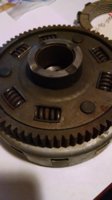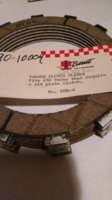I responded to a close by craigslist for sale add. It was for a xs650 clutch for 10 bucks, and another 15 for a unused set of 6 Barnett clutch disks.
In the clutch it has 6 disks and I dont know haw many friction plates and on the back it has 6 springs on the inside. There are markings on the front of the clutch K.D.C. and 34101.
The unused disks are marked BT&E YPK-4. I see they are used in some 650's but I do not know what years. Ive included pictures but not sure they will post as my phone takes pictures that are over 2 meg each.
Any help to let me know what these are would be appreciated. Ive got a 76 xs getting ready to finish it up and would like to know if I should put the Barnett plates in. thanks
In the clutch it has 6 disks and I dont know haw many friction plates and on the back it has 6 springs on the inside. There are markings on the front of the clutch K.D.C. and 34101.
The unused disks are marked BT&E YPK-4. I see they are used in some 650's but I do not know what years. Ive included pictures but not sure they will post as my phone takes pictures that are over 2 meg each.
Any help to let me know what these are would be appreciated. Ive got a 76 xs getting ready to finish it up and would like to know if I should put the Barnett plates in. thanks




